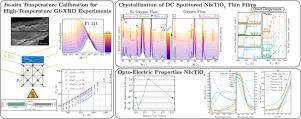在真空中对原始和Nb掺杂TiO2−x薄膜的高温XRD实验进行了原位温度校准
IF 6.3
2区 材料科学
Q2 CHEMISTRY, PHYSICAL
引用次数: 0
摘要
提出了一种在高真空条件下进行的高温掠入射x射线衍射实验的原位温度标定技术。利用晶体铂薄膜的热晶格扩展将样品中的温度校准到热电偶测量的控制温度。这使得薄膜晶体结构的精确热分析具有小于10 K的不确定度。利用这种技术,我们研究了金属-陶瓷复合靶材通过直流磁控溅射沉积的原始和掺杂铌的二氧化钛薄膜的结晶行为。在不同的靶材成分和工艺条件下,对结晶起始温度和结构演变进行了评估,结果表明,在真空退火过程中,复合靶材中金属含量的增加往往会促进金红石相的形成。对于含有10wt%铌的目标-被认为是透明导电氧化物应用中最有前途的-氧流量变化进行了评估。结果表明,在沉积过程中,随着氧的流动,晶格的变化有显著差异。在氩气中引入0.2%的氧气,足以在热处理过程中形成纯锐钛矿相,产生1.2 m Ω cm的最小电阻率。我们的研究结果强调了氧含量在定制二氧化钛基薄膜的结构和光电性能方面的关键作用,为最佳工艺窗口的定义提供了重要的见解。本文章由计算机程序翻译,如有差异,请以英文原文为准。

In-situ temperature calibration for high temperature XRD experiments in vacuum demonstrated on pristine and Nb doped TiO2−x thin films
We present an in-situ temperature calibration technique for high temperature grazing incident X-ray diffraction experiments conducted in high-vacuum. Thermal lattice extension of a crystalline platinum thin film is used to calibrate the temperature in the sample to the control-temperature measured by a thermocouple. This enables a precise thermal analysis of thin film crystal structures with an uncertainty of less than 10 K. Using this technique, we examine the crystallization behavior of pristine and niobium-doped titanium dioxide thin films, deposited by direct current magnetron sputtering from metal–ceramic composite targets. Crystallization onset temperatures and structural evolution were assessed for various target compositions and process conditions, revealing that increased metal content in the composite target tends to promote rutile phase formation during vacuum annealing. For the target containing 10wt% niobium – identified as the most promising for a transparent conductive oxide application – an oxygen flow variation is evaluated. Results reveal significant differences in the crystal lattice depending on the oxygen flow during deposition. Introducing 0.2 % oxygen to the argon process gas is sufficient to induce the formation of pure anatase phase during heat treatment, yielding a minimum resistivity of 1.2 m Ω cm. Our findings highlight the crucial role of oxygen content in tailoring both the structural and opto-electrical properties of titanium dioxide based thin films, providing essential insights for the definition of optimal process windows.
求助全文
通过发布文献求助,成功后即可免费获取论文全文。
去求助
来源期刊

Journal of Alloys and Compounds
工程技术-材料科学:综合
CiteScore
11.10
自引率
14.50%
发文量
5146
审稿时长
67 days
期刊介绍:
The Journal of Alloys and Compounds is intended to serve as an international medium for the publication of work on solid materials comprising compounds as well as alloys. Its great strength lies in the diversity of discipline which it encompasses, drawing together results from materials science, solid-state chemistry and physics.
 求助内容:
求助内容: 应助结果提醒方式:
应助结果提醒方式:


